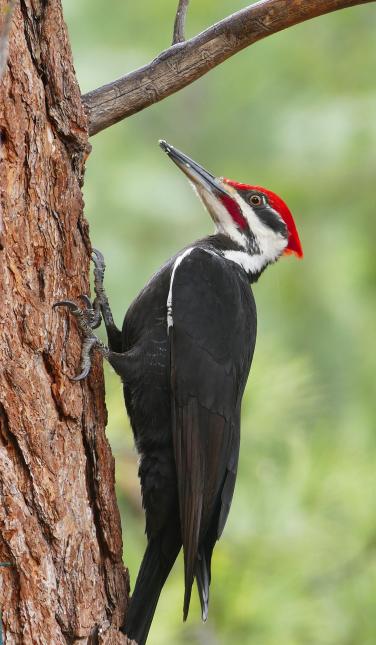Discover the Fascinating World of Woodpeckers: Whatever You Required to Know
The globe of woodpeckers is a realm filled with distinct behaviors, detailed adaptations, and a varied variety of types. From their environments and distribution patterns to their feeding routines and specialized physiological functions, woodpeckers have actually long mesmerized the interest of ornithologists and nature lovers alike. Understanding the complexities of these remarkable birds supplies a look into the intricate interplay between their biology and the atmosphere. As we discover the world of woodpeckers better, we reveal a wide range of information that clarifies their importance in communities and the obstacles they deal with in an ever-changing globe.
Woodpecker Habitats and Circulation
In North America, for example, woodpeckers can be spotted in both coniferous and deciduous forests, using their solid beaks to forage for bugs and produce nesting dental caries in trees. In Africa, specific woodpecker species have actually adjusted to arid settings, such as the acacia timberlands, where they play a critical duty in managing insect populaces.

Feeding Behaviors and Diet Plan
Amongst the different elements of their habits, woodpeckers show distinct feeding routines and nutritional preferences. These birds are mainly insectivores, with a diet that includes ants, beetles, caterpillars, and other insects found in trees. Woodpeckers use their solid beaks to drill right into the bark of trees, penetrating for insects and larvae concealed below the surface area. Along with bugs, woodpeckers likewise consume nuts, seeds, fruits, and sap. Some species have specialized tongues with barbed tips that aid them extract pests from holes in timber.
Woodpeckers are known for their drumming behavior, which serves not only to interact with various other woodpeckers but likewise to locate food. The fast drumming noise is produced by the bird pecking on resonant surfaces like dead trees or steel poles. This behavior can bring in insects concealed in the wood, permitting the woodpecker to find their presence and feed upon them.
Unique Adaptations for Tree Climbing
In their adept quest of bugs hidden within tree bark, woodpeckers have click to investigate evolved amazing anatomical features that furnish them with one-of-a-kind adjustments for reliable tree climbing. One of the key adjustments is their zygodactyl feet, with 2 toes aiming ahead and 2 directing in reverse, providing a strong grasp on tree trunks. This specific foot plan permits woodpeckers to hold on to upright surface areas easily, enabling them to go up and down trees with dexterity. Furthermore, woodpeckers have rigid tail plumes that work as a supportive prop while they climb, aiding in balance and stability. Their strong, chisel-like beaks are not only made use of for drilling into timber however also for grasping onto bark as they ascend tree trunks. Additionally, woodpeckers have solid neck muscle mass and an unique head framework that absorb the influence of constant pecking, allowing them to climb up vertically without triggering damage to their minds. These adaptations showcase the amazing transformative style that makes it possible for woodpeckers to browse trees with precision and efficiency.
Diverse Woodpecker Variety Worldwide
With over 200 various varieties spread throughout different habitats worldwide, the family of Picidae includes an amazing diversity of woodpeckers. These birds can be found in forests, woodlands, savannas, and even urban locations, showcasing their adaptability to different atmospheres. From the legendary Northern Flicker in North America to the vibrant and elusive Crimson-backed Flameback in Asia, each woodpecker types exhibits one-of-a-kind attributes in terms of tuft, behavior, and environment preference.
Woodpeckers vary greatly in size, with the published here small Downy Woodpecker determining around 6-7 inches in length, while the effective Lineated Woodpecker can reach up to 17 inches - Woodpeckers in Florida. Their beaks also come in different forms and sizes, mirroring their feeding behaviors. Some types specialize in extracting pests from tree bark, like the Acorn Woodpecker, while others, such as the Black-cheeked Woodpecker, feed upon fruits and seeds

Preservation Efforts and Challenges
Preservation campaigns for woodpecker populations are critical in alleviating the impact of environment loss and other hazards facing these diverse bird types. Woodpeckers deal with various difficulties to their survival, primarily due to logging, urbanization, environment modification, and invasive species. To attend to these concerns, preservation efforts focus on shielding and bring back woodpecker environments, carrying out lasting forestry methods, and increasing understanding about the significance of these birds in communities.
One significant challenge in woodpecker preservation is the fragmentation linked here of their environments, causing isolated populations that are more at risk to extinction - Woodpeckers in Florida. Conservationists function to produce wildlife corridors and shielded locations that link these fragmented habitats, permitting woodpeckers to move between various areas for feeding, breeding, and sanctuary

Final Thought
In verdict, woodpeckers are remarkable birds with one-of-a-kind adjustments for tree climbing and feeding actions. They can be located in varied environments worldwide, encountering preservation obstacles as a result of environment loss and human tasks. Recognizing their environments, diet plans, and habits is vital for preservation efforts to safeguard these essential bird species. Further research and preservation activities are required to make sure the survival of woodpeckers in the wild.
Comments on “Woodpeckers in Florida: Natural History, Ecology, and Conservation”